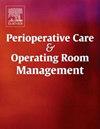Covering sterile instrument tables to prevent airborne bacterial contamination and surgical wound infections: A narrative review of operating room nursing practices
IF 1
Q2 Nursing
Perioperative Care and Operating Room Management
Pub Date : 2025-04-23
DOI:10.1016/j.pcorm.2025.100495
引用次数: 0
Abstract
Surgical wound infections (SWIs) present a major challenge in postoperative care. Covering prepared sterile instrument tables (PSITs) during both idle (inactive) and active surgical phases can significantly reduce contamination by airborne bacteria-carrying particles (ABCPs) that may reach surgical wounds. This narrative review aimed to investigate four key objectives: (1) exploring the role of ABCPs in contaminating PSITs and contributing to SWIs; (2) evaluating the effectiveness of table coverage by operating room nurses (ORNs) in mitigating ABCP during both idle and active surgical periods; (3) assessing the duration of sterility maintained by covered tables and the efficacy of different covering techniques; and (4) recommending optimal covering methods while emphasizing the critical role of ORNs in standardizing and implementing these practices to enhance infection prevention protocols.
A comprehensive search was conducted in MEDLINE, CINAHL, Cochrane, Embase, PubMed, Scopus, Web of Science, and Google Scholar, with a focus on articles examining the role of ORNs in covering sterile instrument tables, preventing airborne contamination, and reducing the incidence of SWIs. Grey literature from the Association of perioperative Registered Nurses (AORN) and the Association of Surgical Technologists (AST) was also reviewed. The literature consistently shows that ORNs play a key role in reducing airborne contamination by covering PSITs during both idle and active phases. The single-drape cover method was effective for up to 60 min, while the double-layer covering provided longer protection, particularly useful during patient transfers in the operating room (OR). Covered PSITs demonstrated minimal contamination even after 24 h in controlled environments, supporting evidence that PSIT covering effectively reduces ABCP contamination and maintains sterility for up to 60 min. This is especially important in complex surgeries, where sterility is crucial for patient safety. Moreover, covering PSITs during both idle and active periods significantly lowers contamination levels compared to uncovered PSITs.
覆盖无菌手术台以防止空气中的细菌污染和手术伤口感染:手术室护理实践的叙述性回顾
手术伤口感染(SWIs)是术后护理的主要挑战。在手术的空闲(非活动)和活动阶段覆盖准备好的无菌手术台(psit)可以显著减少可能到达手术伤口的空气携带细菌颗粒(ABCPs)的污染。本综述旨在探讨四个关键目标:(1)探索abcp在污染psit和促进SWIs中的作用;(2)评估手术室护士(手术室护士)在手术空闲期和手术活跃期减轻ABCP的有效性;(3)评估覆盖台面保持无菌的持续时间和不同覆盖技术的效果;(4)推荐最佳覆盖方法,同时强调手术室在规范和实施这些做法以加强感染预防方案方面的关键作用。我们在MEDLINE、CINAHL、Cochrane、Embase、PubMed、Scopus、Web of Science和b谷歌Scholar中进行了全面的检索,重点研究了手术室在覆盖无菌仪器台、防止空气污染和降低SWIs发生率方面的作用。来自围手术期注册护士协会(AORN)和外科技师协会(AST)的灰色文献也进行了回顾。文献一致表明,通过在空闲和活跃阶段覆盖psit, nr在减少空气污染方面发挥了关键作用。单层覆盖方法的有效时间长达60分钟,而双层覆盖提供更长时间的保护,在手术室(OR)患者转移期间特别有用。即使在受控环境中放置24小时,覆盖的PSIT也显示出最小的污染,这支持了PSIT覆盖有效减少ABCP污染并保持无菌长达60分钟的证据。这在复杂手术中尤其重要,无菌对患者安全至关重要。此外,与未覆盖的psit相比,在空闲和活动期间覆盖psit可显著降低污染水平。
本文章由计算机程序翻译,如有差异,请以英文原文为准。
求助全文
约1分钟内获得全文
求助全文
来源期刊

Perioperative Care and Operating Room Management
Nursing-Medical and Surgical Nursing
CiteScore
1.30
自引率
0.00%
发文量
52
审稿时长
56 days
期刊介绍:
The objective of this new online journal is to serve as a multidisciplinary, peer-reviewed source of information related to the administrative, economic, operational, safety, and quality aspects of the ambulatory and in-patient operating room and interventional procedural processes. The journal will provide high-quality information and research findings on operational and system-based approaches to ensure safe, coordinated, and high-value periprocedural care. With the current focus on value in health care it is essential that there is a venue for researchers to publish articles on quality improvement process initiatives, process flow modeling, information management, efficient design, cost improvement, use of novel technologies, and management.
 求助内容:
求助内容: 应助结果提醒方式:
应助结果提醒方式:


